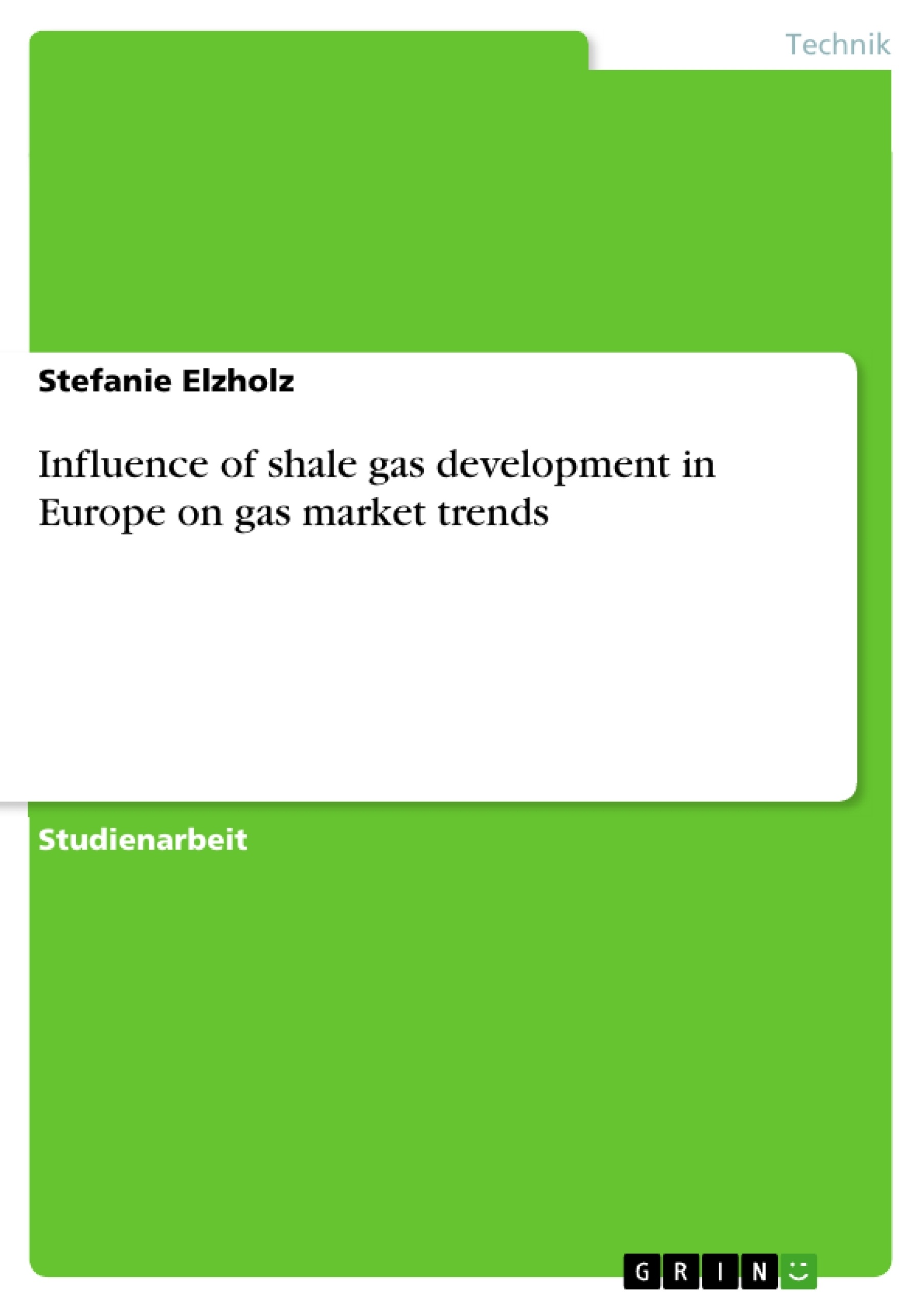In Europe, a “new” unconventional energy resource begins to be explored. The so called shale gas isn’t a new discovery, but its production has been too complex and expensive for a long time. Since rough quantities of shale gas have been exploited in North America, the global gas markets are changing. The European gas market is also affected by these changes which are characterized by an increasing gas supply and declining prices. Since Europe also has shale gas resources, the production of this unconventional gas might be attractive now. The present report investigates and evaluates the shale gas potentials in Europe. Against the background of energy policy targets like supply security and carbon emissions reduction, the option of shale gas as solution approach for these targets has to be evaluated. Although the production is meanwhile mostly profitable, active exploitation in Europe is not yet carried out because environmental concerns and the “green” lobby are countering. Nonetheless, shale gas is most likely to take a significant share of the future energy mix.
Inhaltsverzeichnis
- 1 Introduction
- 2 Fundamental basics about shale gas
- 2.1 Definition and classification in the natural gas
- 2.2 Production process
- 2.3 Environmental concerns
- 2.4 Sources and potential worldwide
- 3 Shale gas developments in Europe
- 3.1 Overview over the European gas market
- 3.2 Sources and potential of shale gas
- 3.3 Selected ongoing projects
- 3.3.1 Poland
- 3.3.2 Eastern Europe
- 3.3.3 Germany
- 3.4 Influence on gas market trends
- 4 Conclusion
Zielsetzung und Themenschwerpunkte
Dieser Bericht untersucht das Potenzial von Schiefergas in Europa und dessen Einfluss auf die Gasmarktentwicklung. Die Analyse betrachtet die wirtschaftlichen, ökologischen und politischen Aspekte der Schiefergasförderung im europäischen Kontext.
- Bewertung des Schiefergaspotenzials in Europa
- Analyse der Auswirkungen auf die europäische Gasmarktstruktur
- Diskussion der ökologischen Bedenken im Zusammenhang mit der Schiefergasförderung
- Beurteilung der Rolle von Schiefergas im Hinblick auf Energiepolitikziele
- Untersuchung ausgewählter Projekte in Polen, Osteuropa und Deutschland
Zusammenfassung der Kapitel
1 Introduction: Der einleitende Abschnitt führt in die Thematik ein und beschreibt die wachsende Bedeutung von Schiefergas als nicht-konventionelle Energiequelle. Er hebt hervor, dass obwohl Schiefergas nicht neu entdeckt wurde, seine Förderung aufgrund vergangener technischer und wirtschaftlicher Herausforderungen erst in jüngster Zeit in größerem Umfang möglich geworden ist, insbesondere durch die Erfahrungen in Nordamerika. Der Bericht kündigt die anschließende Untersuchung des europäischen Schiefergaspotenzials an, insbesondere im Kontext von Energiepolitikzielen wie Versorgungssicherheit und Emissionsreduktion.
2 Fundamental basics about shale gas: Dieses Kapitel liefert grundlegende Informationen über Schiefergas. Es definiert Schiefergas im Kontext anderer Erdgasarten, beschreibt den komplexen und kostenintensiven Förderprozess (Hydraulic Fracturing), beleuchtet die damit verbundenen Umweltbedenken (z.B. Wasserverschmutzung, Methanemissionen) und präsentiert eine Übersicht über die weltweiten Vorkommen und das potenzielle Fördervolumen. Die Darstellung des Produktionsprozesses und der Umweltaspekte bildet die Basis für die spätere Bewertung der europäischen Situation.
3 Shale gas developments in Europe: Dieser Abschnitt konzentriert sich auf die Entwicklung von Schiefergas in Europa. Er beginnt mit einer Übersicht über den europäischen Gasmarkt, analysiert das europäische Schiefergaspotenzial und beschreibt ausgewählte laufende Projekte in Polen, Osteuropa und Deutschland. Die Analyse der Marktstruktur und der Projekte dient der Abschätzung des zukünftigen Einflusses von Schiefergas auf den europäischen Gasmarkt. Die regionale Differenzierung ermöglicht eine differenzierte Betrachtung der Herausforderungen und Chancen.
Schlüsselwörter
Schiefergas, Erdgas, Gasmarkt, Europa, Energiepolitik, Umwelt, Versorgungssicherheit, Hydraulic Fracturing, Fracking, Emissionsreduktion, Projekte, Polen, Osteuropa, Deutschland
Häufig gestellte Fragen zum Bericht: Schiefergas in Europa
Was ist der Inhalt dieses Berichts?
Dieser Bericht bietet eine umfassende Übersicht über das Potenzial von Schiefergas in Europa und dessen Auswirkungen auf die Gasmarktentwicklung. Er beinhaltet eine Einleitung, grundlegende Informationen zu Schiefergas, eine detaillierte Analyse der europäischen Entwicklungen, sowie eine Schlussfolgerung. Der Bericht betrachtet wirtschaftliche, ökologische und politische Aspekte der Schiefergasförderung.
Welche Themen werden im Bericht behandelt?
Der Bericht behandelt folgende Themen: Definition und Klassifizierung von Schiefergas, den Produktionsprozess (Hydraulic Fracturing), Umweltbedenken, weltweite Vorkommen, den europäischen Gasmarkt, das europäische Schiefergaspotenzial, laufende Projekte in Polen, Osteuropa und Deutschland, den Einfluss auf Gasmarkt-Trends und die Rolle von Schiefergas in der Energiepolitik.
Welche Kapitel umfasst der Bericht?
Der Bericht gliedert sich in vier Kapitel: Kapitel 1 (Einleitung), Kapitel 2 (Grundlagen zu Schiefergas), Kapitel 3 (Schiefergasentwicklungen in Europa) und Kapitel 4 (Schlussfolgerung).
Welche Länder werden im Bericht besonders betrachtet?
Der Bericht konzentriert sich auf die Entwicklungen in Polen, Osteuropa und Deutschland, untersucht aber auch den europäischen Gasmarkt als Ganzes.
Welche Aspekte der Schiefergasförderung werden analysiert?
Der Bericht analysiert wirtschaftliche Aspekte (Marktstrukturen, Potenzial), ökologische Aspekte (Umweltbelastung, Emissionen) und politische Aspekte (Energiepolitik, Versorgungssicherheit) der Schiefergasförderung.
Welche Schlüsselwörter beschreiben den Bericht am besten?
Schlüsselwörter sind: Schiefergas, Erdgas, Gasmarkt, Europa, Energiepolitik, Umwelt, Versorgungssicherheit, Hydraulic Fracturing, Fracking, Emissionsreduktion, Projekte, Polen, Osteuropa, Deutschland.
Was ist das Ziel des Berichts?
Das Ziel des Berichts ist die Untersuchung des Potenzials von Schiefergas in Europa und dessen Einfluss auf die Gasmarktentwicklung unter Berücksichtigung der wirtschaftlichen, ökologischen und politischen Aspekte.
Welche Zusammenfassung der Kapitel bietet der Bericht?
Der Bericht bietet Kapitelzusammenfassungen, die die wichtigsten Punkte jedes Kapitels kurz und prägnant beschreiben. Diese Zusammenfassungen geben einen Überblick über den Inhalt und die Kernaussagen jedes Kapitels.
- Quote paper
- Stefanie Elzholz (Author), 2011, Influence of shale gas development in Europe on gas market trends, Munich, GRIN Verlag, https://www.grin.com/document/271435



